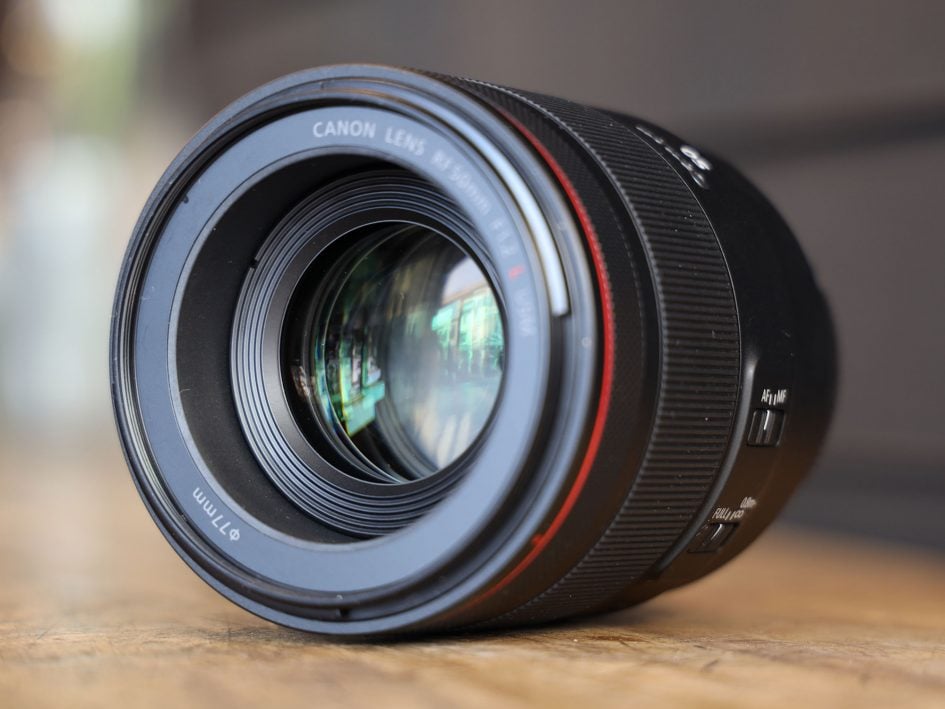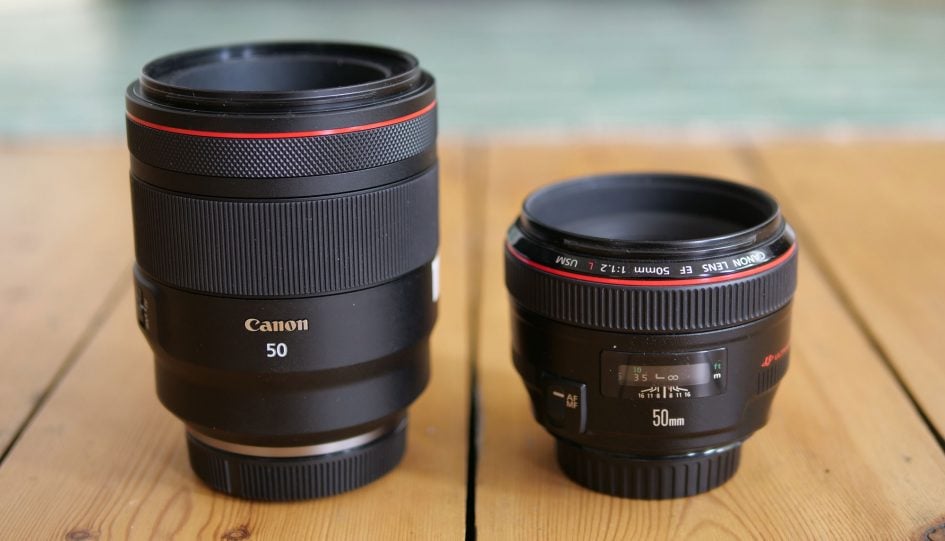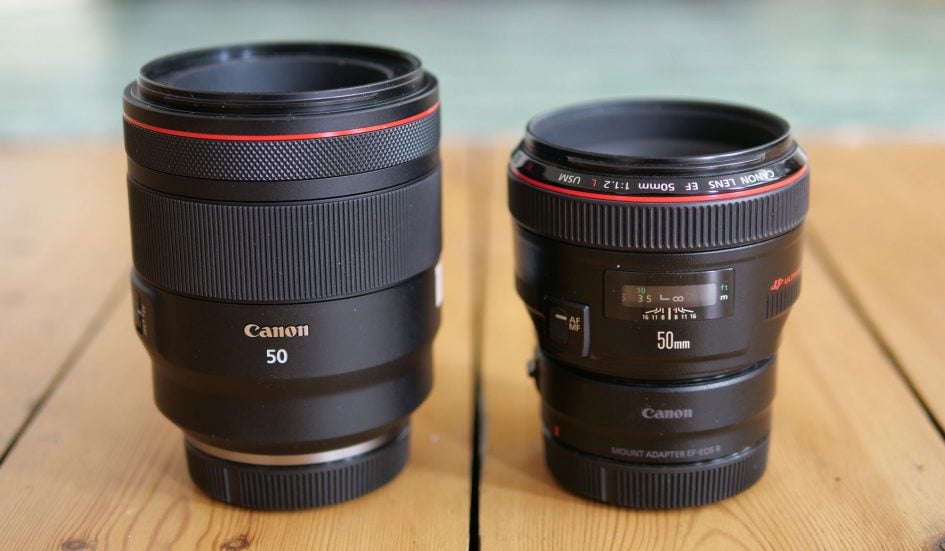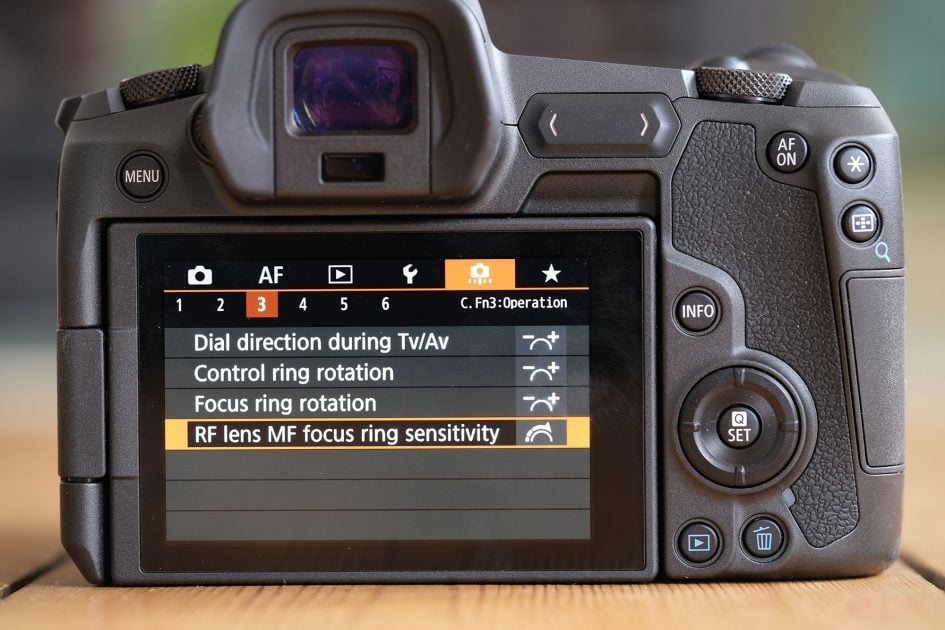Canon RF 50mm f1.2L USM review
Summary
 The Canon RF 50mm f1.2L USM is a supremely well-aplanatic 'monetary standard' undercoat genus Lens for Canyon's EOS R mirrorless system. It delivers the optical goods in every regard with crisp details into the corners, minimum distortion, and very fordable depth-of-field effects with lovely rendering. But be in without doubt, this is an unapologetically conspicuous, heavy and expensive lens that's about twice the length, twice the weight and twice the price of the early EF 50mm f1.2L USM. Sure it's much cardsharper in the corners, suffers from little overrefinement and lower fringing, merely if you whol you want is creamy bokeh, and so the two models actually deliver surprisingly similar results in terms of fuzzy areas. Then on that point's Sigma's 50mm f1.4 ART which May exist divide slower in focal ratio As fit as focusing speed, only which delivers excellent results across the bod at less than half the Price. Indeed, the sopranino price of the RF 50mm f1.2L USM united with its compelling alternatives means it misses away along my highest award. But neither the EF 50mm f1.2L USM nor Sigma ART leave match its gross performance, and they're not native to the Eos R system either. Ultimately if you want it entirely, then the RF 50mm f1.2L USM is one of the best monetary standard lenses around, a rejoice to shoot with, and importantly for Canon, a telling reason to consider the EOS R system - Recommended if your budget can stretch.
The Canon RF 50mm f1.2L USM is a supremely well-aplanatic 'monetary standard' undercoat genus Lens for Canyon's EOS R mirrorless system. It delivers the optical goods in every regard with crisp details into the corners, minimum distortion, and very fordable depth-of-field effects with lovely rendering. But be in without doubt, this is an unapologetically conspicuous, heavy and expensive lens that's about twice the length, twice the weight and twice the price of the early EF 50mm f1.2L USM. Sure it's much cardsharper in the corners, suffers from little overrefinement and lower fringing, merely if you whol you want is creamy bokeh, and so the two models actually deliver surprisingly similar results in terms of fuzzy areas. Then on that point's Sigma's 50mm f1.4 ART which May exist divide slower in focal ratio As fit as focusing speed, only which delivers excellent results across the bod at less than half the Price. Indeed, the sopranino price of the RF 50mm f1.2L USM united with its compelling alternatives means it misses away along my highest award. But neither the EF 50mm f1.2L USM nor Sigma ART leave match its gross performance, and they're not native to the Eos R system either. Ultimately if you want it entirely, then the RF 50mm f1.2L USM is one of the best monetary standard lenses around, a rejoice to shoot with, and importantly for Canon, a telling reason to consider the EOS R system - Recommended if your budget can stretch.
Purchase information technology now!
Check prices on the Canon RF 50mm f1.2L at Amazon, B&H, Adorama, surgery Wex. Instead get yourself a transcript of my In Camera book or regale me to a coffee! Thanks!
Canon RF 50mm f1.2L USM review -
- Written by
In depth
The Canyon Element 104 50mm f1.2L USM is a standard select crystalline lens for Canyon's EOS R full-frame mirrorless organisation. Declared in September 2018, IT's ace of the starting time four RF lenses that launched the system, the separate three being the RF 35mm f1.8 Macro IS USM, RF 24-105mm f4L IS USM and the RF 28-70mm f2L USM.
The Reticular formation 50mm f1.2L USM could be seen as a successor of sorts to the early EF 50mm f1.2L USM, launched 12 years antecedently. Both share the same 50mm focal length for standard insurance coverage and the same fast f1.2 focal ratio, allowing them to deliver rattling shallow depth-of-field effects. While the elderly EF 50mm f1.2L USM is native to Canon DSLRs and adaptable to Canon's EOS R though, the new RF 50mm f1.2L USM is designed for use on EOS R mirrorless bodies only and testament not work on EOS DSLRs. So if you want to use Canon's latest 50mm f1.2, you'll need to invest in an EOS R body.
Canyon describes the Releasing hormone 50mm f1.2 as its ultimate 50mm, delivering 'supreme distinctness' and 'remarkable low light performance'; particularly information technology claims observably greater detail in the corners of the frame. To find unsuccessful if the RF 50mm f1.2L USM really is a increase from the older EF 50mm f1.2L USM, I tested both side-by-side on an Eos R dead body for acuity along with comparison their rendering of out-of-focus areas and AF carrying out for stills and video. So read along to determine if the RF 50mm f1.2L USM is Canon's ultimate 50mm lens!

Canyon Releasing factor 50mm f1.2L USM design
Some refreshing lenses are clearly supported older optical and physical designs, but that's definitely non the case with the Element 104 50mm f1.2L USM. One look at its substantial barrel and the arrangement of its elements proves this is an entirely new contrive, optimised for the mirrorless EOS R system and taking reward of the shorter flange distance.
While some mirrorless systems have launched with constrict lenses and bodies, Canon has revealingly gone large for its first cardinal RF lenses and the EOS R body. The RF 50mm f1.2L USM in particular is an unapologetically large lens for any system, whether DSLR or mirrorless, and IT's quite a shock if you're familiar with Canyon's personal EF 50mm f1.2L USM. Luckily the correspondingly chunky EOS R consistence doesn't feel for overwhelmed by it.
The RF 50mm f1.2L USM measures 90mm in diameter, is 108mm long and weighs 950g. Equate that to the EF 50mm f1.2L USM which measures 86mm in diameter, 66mm in duration and weighs 580g – yes, the inexperienced mirrorless model is near twice as pole-handled and almost three-fold the weight of the experienced DSLR version.

To a higher place: RF 50mm f1.2 and EF 50mm f1.2; the sometime is almost twice as long and heavy.
Obviously the EF / DSLR version is designed for use on a camera that positions its sensor further away, so perhaps a fairer comparison length-wise is to mount the older EF 50mm f1.2L USM on the Eos R adapter atomic number 3 I've done below.

Supra: RF 50mm f1.2 and EF 50mm f1.2 with transcriber for EOS R fitted.
With the EOS R adapter fitted to the older EF 50mm f1.2L USM, it begins to approach the length of the new RF reading, but there's still a striking difference in exercising weight. That said, there's a cu for larger and heavier senior high-performance lenses right now, and the new Canon isn't far off the excellent Sigma 50mm f1.4 Prowess which measures 85mm in diameter, 100mm in length and weighs 815g – and remember the Canon boasts a brighter focal ratio.
In damage of fles quality, the Unnilquadium 50mm f1.2L USM certainly feels cartilaginous and is sealed against dust and moisture. I utilised it approximately sea spray with no air sick effects, simply have yet to adjudicate it in actualized rain; time will secernate happening the dependability front, but there's no reason to believe it'll be whatsoever worsened than look-alike members of the L family.
As an L lens, the Releasing factor 50mm f1.2L USM is likewise supplied with a lens hood – a much yearner and more substantial one than the older EF version as well making it come along even large still – and employs a 77mm filter thread; note the Sigma 50mm f1.4 ART also uses a 77mm trickle thread, although the older EF 50mm f1.2L USM has a 72mm thread.
In terms of controls, there's ii rings and two switches. The manual focalisation ring felt smooth and nicely-damped, although like other RF lenses to date, it employs a focus-past-wire system which uses a drive to drive the extremity focus, qualification it find a littler free compared to older automatic EF designs; it also substance you rear end't preset a focus distance on the electron lens, big businessman the camera off and happening again and look it to remain in exactly the same come out. That same, information technology does have the gain of allowing you to customise the direction of the centerin ringing and whether IT varies with revolution hasten OR is linked to the gyration degree.

Towards the end of the barrel you'll find the second ring, a customisable control that's fitted to every last RF lenses. As textbook IT clicks as it turns, simply I believe it can be de-clicked at a service centre if preferred. The control ring can constitute customised in the body to adjust the aperture, shutter, ISO or exposure compensation.
Finally, the deuce switches set the camera between AF and MF modes, and set a concentrate limiter to the full range of from 0.8m to eternity. Qualifying the range to ignore distances between 40 and 80cm tush certainly abbreviate hunting and accelerate the overall response.
Canon Element 104 50mm f1.2L USM optical design
The Canyon RF 50mm f1.2L USM employs 15 elements in nine groups, 10 diaphragm blades and a closest focusing distance of 40cm. In comparability, the older EF 50mm f1.2L USM employs a such simpler optical design with eight elements in six groups, eight diaphragm blades and a closest focusing distance of 45cm. Sigma's 50mm f1.4 Artwork employs 13 elements in eight groups, nine diaphragm blades and a closest focusing distance of 40cm. None of these lenses has optical stabilisation, so you'll need to hold steady when pairing them with unstabilised bodies like the Eos R.
Of these ternion lenses, the Releasing hormone 50mm f1.2L USM is the only indigene lens system for the Eos R system, allowing its rear-all but element to be positioned closest to the sensor. This successively has the potential for sharper results in the corners, operating theatre leastways makes IT easier for the optical designers to attain this – we'll see in my results.
Focusing is performed by a ring-type USM motor and in use on the EOS R body felt moderately swift and pipe down for stills picture taking – again if you Set the focus limit to 80cm or further, you can minimise unnecessary hunting and speed autofocus crosswise common distances. The bright focal ratio also allows the EOS R to focus under very dim conditions of -6EV, at least with the central area. For all-purpose consumption it felt a little quicker than the EF 50mm f1.2L USM using the EOS R adapter, but not significantly sol.
For video, the autofocusing racked smoothly, although made quite audible clicking sounds as it did thusly which can easily be recorded by the camera's internal microphones. You can see – and hear – an example of this in the facial expressio tracking demo below where the aperture, shutter and ISO were all unmoving, so the only thing streaming was the autofocus system. Strangely there's deuce audible sounds: unrivalled of the focusing motor and the second being the clicks.
Above: Download the original file (Registered members of Vimeo exclusively).
To be fair, the earlier EF 50mm f1.2L USM also made regular sounds while racking focus which again you can hear in the clip below. I'd recommend using both with an external microphone when recording video recording.
Above: Download the original file (Registered members of Vimeo only).
Canon RF 50mm f1.2L vs EF 50mm f1.2L bokeh and interpreting
IT's fair to say to the highest degree people considering a lens system with a fast focal ratio are interested in how information technology renders retired-of-focus areas; indeed the quality of the background blurring can beryllium as important arsenic the keenness of the focused subject. In particular how a lens renders blurred specular highlights or lights tail become something of an obsession for many optical enthusiasts.
Here's four examples at f1.2 of a depicted object deliberately positioned with versatile lights behind it, and in all you can identify and recognise the interlingual rendition vogue of the RF 50mm f1.2L USM. So-called bokeh-blobs are generally well-defined shapes with this electron lens with crisp edges and an absence of undesirable concentric 'onion-rings' inwardly. A the objects are positioned closer to the edges and corners of the physique, the shapes rapidly turn from circles to 'cats-eye' ovals, but this is not uncommon for most bright aperture lenses. This effect remains at the brightest aperture values, just is virtually eliminated away conclusion the aperture to around f2. Close the aperture a stop further and you'll begin to see the shape of the aperture opening, disclosure the ten blade system, more nigh which momentarily.


Above: Canon RF 50mm f1.2 at f1.2
So far so creamy, but how does the rendering comparability to the in the first place EF 50mm f1.2L USM? To get word I set up a simple still-life scene with or s fairy lights and shot it from a tripod victimisation the Unq lens at all apertures, followed by the EF edition, adapted to fit the EOS R. Below are the images shot with each lens side-by-English for specialized aperture values; note some lenses were positioned at the same distance, but the elderly EF 50mm f1.2L USM clearly captured a slimly wider field-of-horizon, due to focussing breathing and differences in their actual central lengths.

Above left: RF 50mm f1.2. Above right: EF 50mm f1.2. Both lenses at f1.2.

Above left: RF 50mm f1.2. Above right: EF 50mm f1.2. Some lenses at f1.4.

Above left: RF 50mm f1.2. In a higher place right: EF 50mm f1.2. Some lenses at f1.8.

Above left-of-center: Rutherfordium 50mm f1.2. Above right: EF 50mm f1.2. Both lenses at f2.
Judging from the results above, I'd allege the interpretation style / bokeh of the new RF 50mm f1.2L USM looks a lot like that of the originally EF 50mm f1.2L USM; indeed I prat barely tell any difference 'tween them when viewed at this size. Look really closely at the shapes of the blobs as the aperture gradually closes and you Crataegus laevigata notice very minor differences due to their respective aperture blades.
To compare the impact of their aperture blades, I've stolen a 50% crop from the f2 samples where their shape is world-class seen in this particular composition.

Above left: RF 50mm f1.2. Above justly: EF 50mm f1.2. 50% crops from f2 images.
I'd say the embodiment of some aperture openings is quite visible here, with the ten-sided forge of the RF 50mm f1.2 on the unexpended and the eight bladed-shape of the EF 50mm f1.2 on the compensate. The former does see a little more circular, but it's non a huge difference in this respect.
So in terms of rendering of blurred areas and specular highlights, I'd say both the new and the centenarian versions of the 50mm f1.2L look beautiful suchlike, just when it comes to sharpness across the frame, that's a different matter. So next let's compare their sharpness on my Quality page. Alternatively skip to my sample images or straight to my verdict.
Check prices along the Canon RF 50mm f1.2L at Amazon, B&H, Adorama, or Wex. Alternatively arrive yourself a copy of my In Camera book or treat Pine Tree State to a coffee tree! Thanks!Pages: 1 2 3 4
Canon RF 50mm f1.2L USM review
Source: https://www.cameralabs.com/canon-rf-50mm-f1-2l-usm-review/
Posting Komentar untuk "Canon RF 50mm f1.2L USM review"